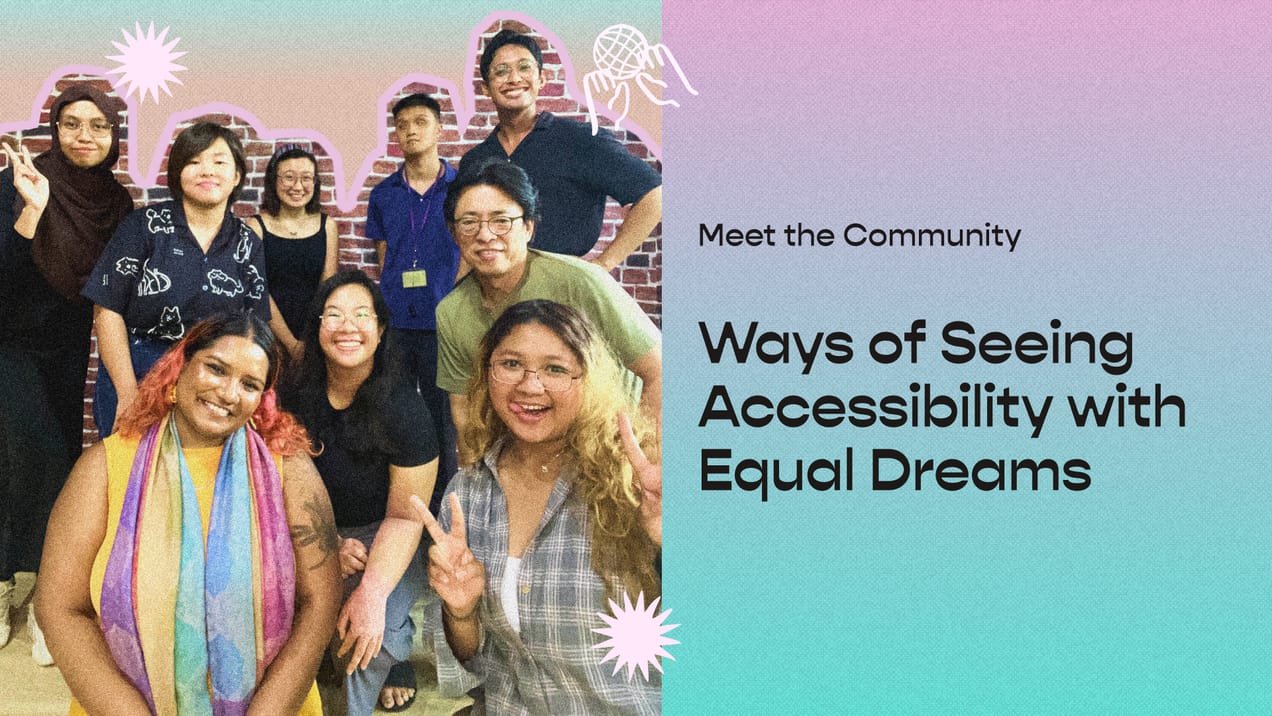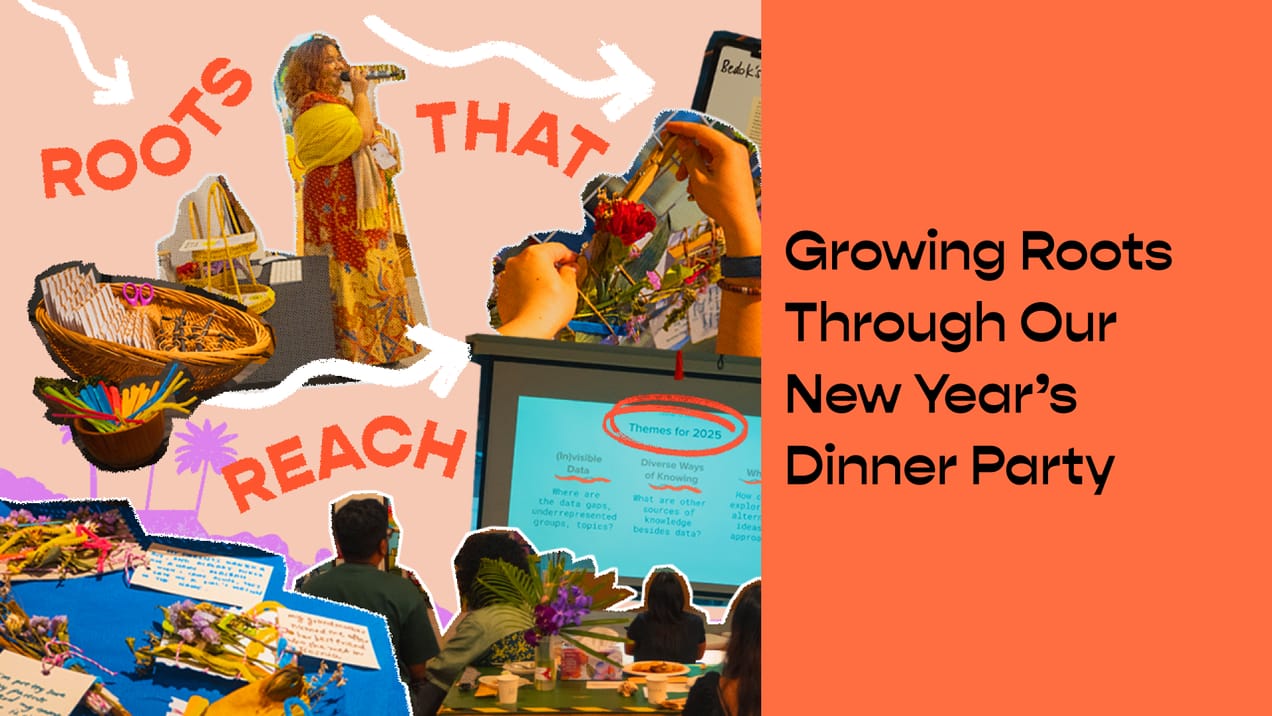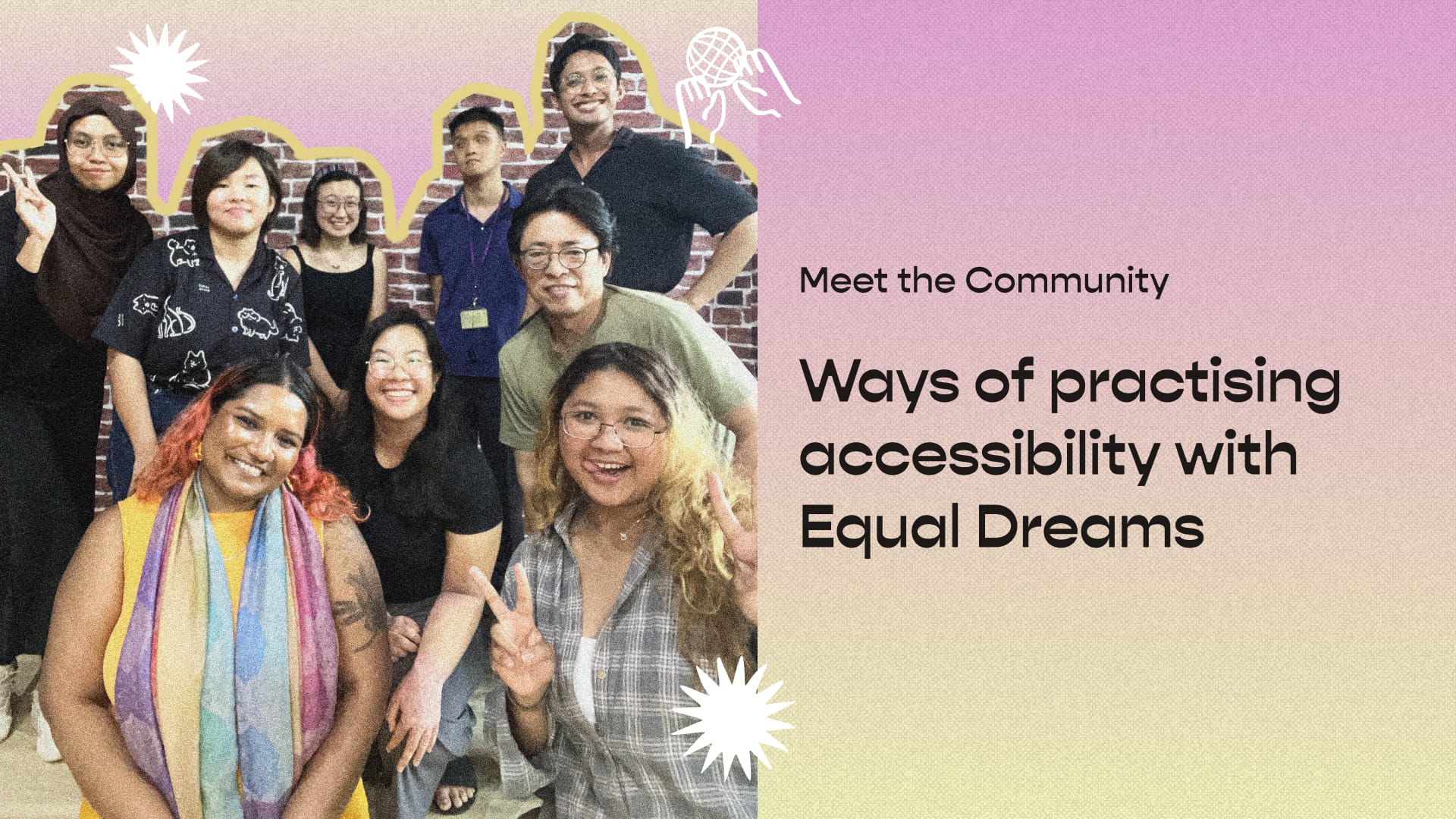
Ways of practising accessibility with Equal Dreams (Part 2)
We sat down with the team behind Equal Dreams, a social business moving the needle forward when it comes to accessibility, to discuss the realities and nuances behind building a more accessible future. This is the second-part of our conversation with them.
In our earlier conversation, we discussed how accessibility is all-encompassing. In this article, we go further to unpack some of the positive changes happening on the ground, and how communities are starting to think differently about access and inclusion. As the journey towards an accessible world is neither linear nor straightforward, we also explore their hopes, and the existing gaps they’ve come across in different industries and regions.
We spoke to: Clara Chee, a Team Lead; Hidayat Khalid, a Team Lead; Neo Kah Wee, a Digital Accessibility Specialist; Minjie Tim, an Accessibility Specialist and Training Developer; Faaiqah Alkaff, a Singapore Sign Language (SgSL) Instructor, Deaf Interpreter and Social Media Manager; Andrew Tay, a Singapore Sign Language (SgSL) Specialist and Deaf Interpreter; and Patricia Merilo, the Digital Accessibility Lead.
This interview was conducted both in-person and asynchronously, so team members could respond live or type their answers during and after the session using a shared Google document. Some members of the team also provided Singapore Sign Language interpretation during the session. Image descriptions in this article were worked on collaboratively with the Equal Dreams team.
Note: The interview responses have been lightly edited and condensed for clarity and length.
Accessibility should be meaningful
Has there been a noticeable shift in how clients or partners engage with accessibility? Are more people now approaching Equal Dreams with greater interest or openness?
Andrew: I notice more people are interested in learning Singapore Sign Language (SgSL). Some want to learn to communicate in the workplace with their deaf colleagues, or some are hearing parents wanting to connect with their deaf children.
Yet there are some who learn SgSL for reasons that disappoint me. Some people think that knowing some signs and vocabulary alone is enough to become an educator of the deaf. That ends up hurting the quality of deaf education, and impacts language acquisition of deaf children. Hearing teachers [who want to teach] deaf children must be knowledgeable in Deaf culture, and fully proficient in SgSL. Knowing some signs here and there is not enough.
Pat: More organisations are recognising the need for access as a way to connect meaningfully with their audiences. What’s been encouraging is the arts scene in Singapore. We’re seeing more performances and events including SgSL interpretation especially by Deaf interpreters, which brings a deeper cultural and linguistic authenticity to the experience. There’s captioning in theatre shows, and even Deaf actors being cast to play Deaf characters, which is a big step toward authentic representation. There are also tactile and sensory-friendly exhibitions that include quiet rooms for those needing a break from sensory input. These additions show that accessibility can be creative, interactive, and human-centred.
More partners are starting to reach out early, wanting to embed access from the start rather than treat it as an afterthought. That shift in mindset is something we’re excited to see grow.
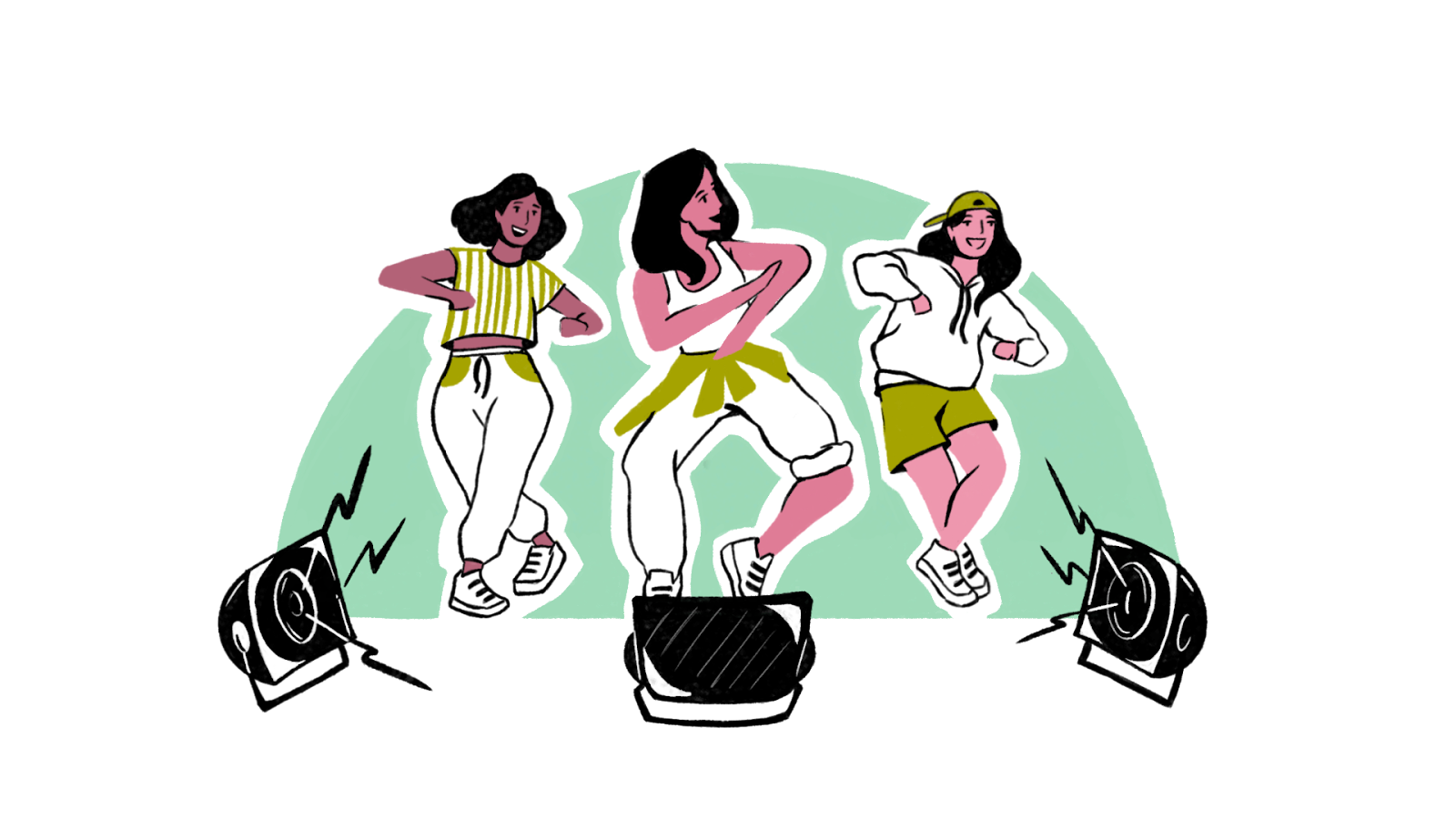
Accessibility should be critical
Minjie: I think with anything that is starting to become more popular, there is also that risk of diluting what access means. It is important to ask: Are you consulting disabled people? If yes, are you compensating them fairly, or are you just exploiting their labour? I hope we move towards people becoming more critical in the way they engage with access and access providers, including us.
This is something I have learned since joining as well. It's very difficult to do access well just through referencing online materials and online guides. You need actual testing and user feedback. I would caution people to use the term “accessible” more carefully and be more specific about exactly what you are providing, instead of claiming that you followed guides and therefore it's accessible, because it's probably not.
Clara: It's important to platform disabled voices and to do so with care. What we’ve been seeing is that maybe there’s one disabled person on a panel, and then it’s framed as “we’ve got lived experience.” But everyone else on the panel is an “expert in DEI (Diversity, Equity & Inclusion)”.
How you word your copywriting and publicity is reflective of how much you are involving disabled people in your process.
More people need to see the amount of potential in including disabled people as consultants, trainers, and access professionals, because there is a level of expertise that you cannot get as a non-disabled person.
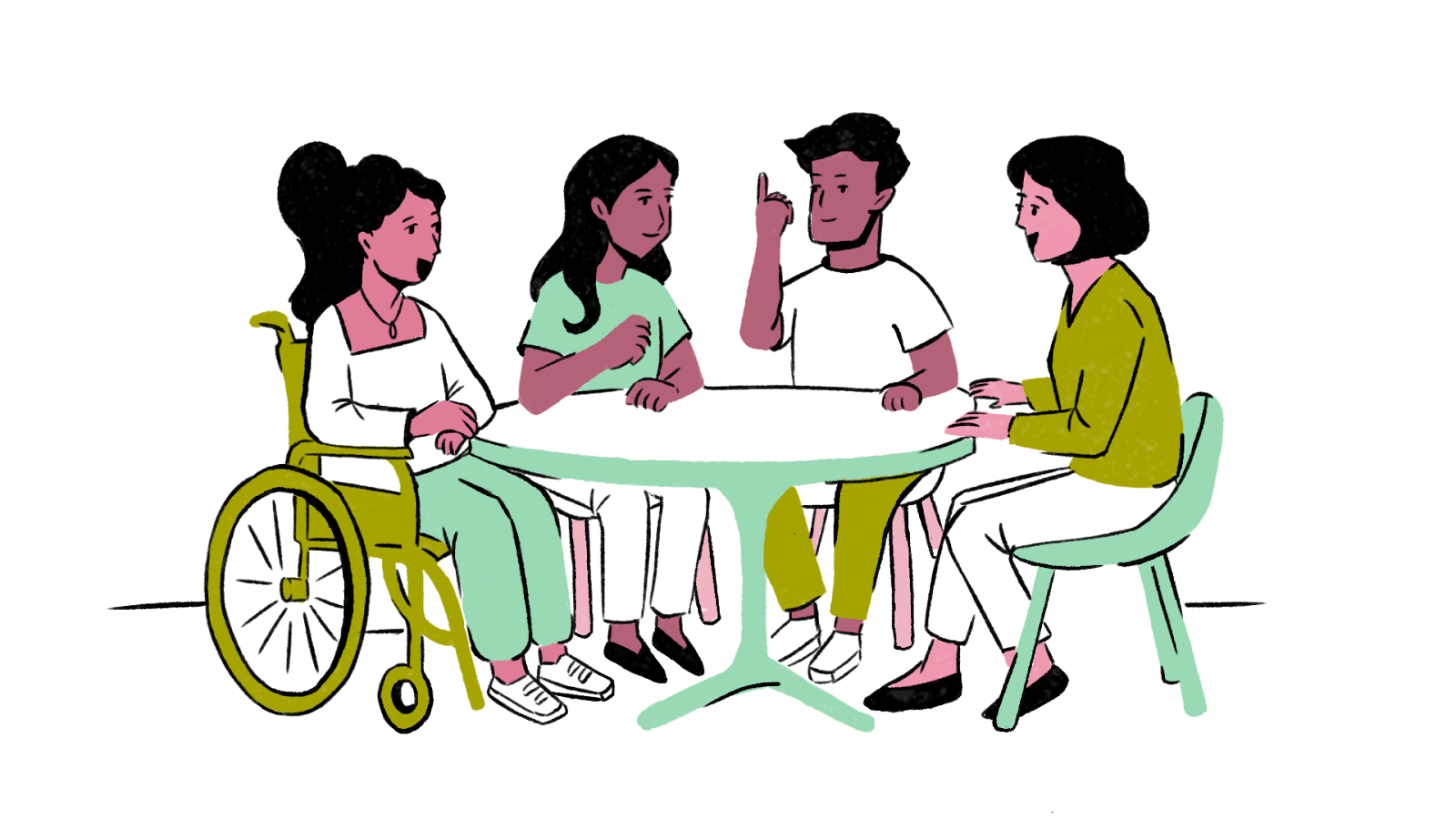
Kah Wee: In a course I attended recently, one of the speakers shared something quite ironic: that while disabled people are usually the ones that use most of the access features that are available, they are often not engaged to test these platforms. Instead, non-disabled people who claim to be professionals are brought in to test the outcomes.
Take ramps, for example. They’re designed for everyone, but the people who use them the most are usually wheelchair users. Yet, organisations often don’t engage them in the design or testing process.
Clara: In the digital space, now more websites have that accessibility icon with a few features linked to it, like increasing the font size or adjusting the colour contrast between text and background. But a website that is truly designed with accessibility in mind integrates it in the code itself. It's something that the programming and developing team considers from the start, not just via an added plugin. Which brings us back to how access needs to be at the forefront of your consideration across different teams.
Pat: One of the most commonly overlooked aspects of digital a11y (a numeronym for “accessibility”) is the human experience behind the screen. Often, people focus on checklists: alt-text, contrast ratios, keyboard navigation which are all important. But a11y isn’t just about technical fixes, it’s about how people actually feel when they use a platform. Do they feel included? Frustrated? Invisible?
In my experience, some things that often get overlooked:
- Lack of captions or transcripts for videos, especially on social media
- Poor structure in documents and websites, making it hard for screen reader users to navigate
- Over-reliance on visuals or audio without alternative formats
- Registrations forms that are not accessible by keyboard or don’t support assistive technology
Accessibility should be contextual.
How have attitudes toward accessibility changed, not just in Singapore, but across Southeast Asia? Are there any movements or organisations that inspired Equal Dreams? How is the landscape changing in the region? We ask this as a lot of our personal reference points for accessibility usually come from the global north.
Clara: Honestly I would say there is a gap in my knowledge. We are currently working on trying to contextualise resources from the global north, or using what we have here, to figure out accessibility and grow the awareness in Singapore specifically. But I do acknowledge that there is a lot of good work being done in Southeast Asia, it's just that we haven't had the chance to build those connections and collaborations yet.
Hidayat: One of our projects was a video that was a collaboration between National Gallery Singapore (NGS) and Beyond Vision International, an organisation based in Hong Kong. We worked closely with the production team and NGS to integrate creative audio description, rather than the traditional approach where audio description is a separate added track. So looking at how they approach access for the blind community and how they are expanding their work to Singapore. I really learned a lot from that experience about how art itself, which is typically something that you don't really touch, can become accessible to the blind community.
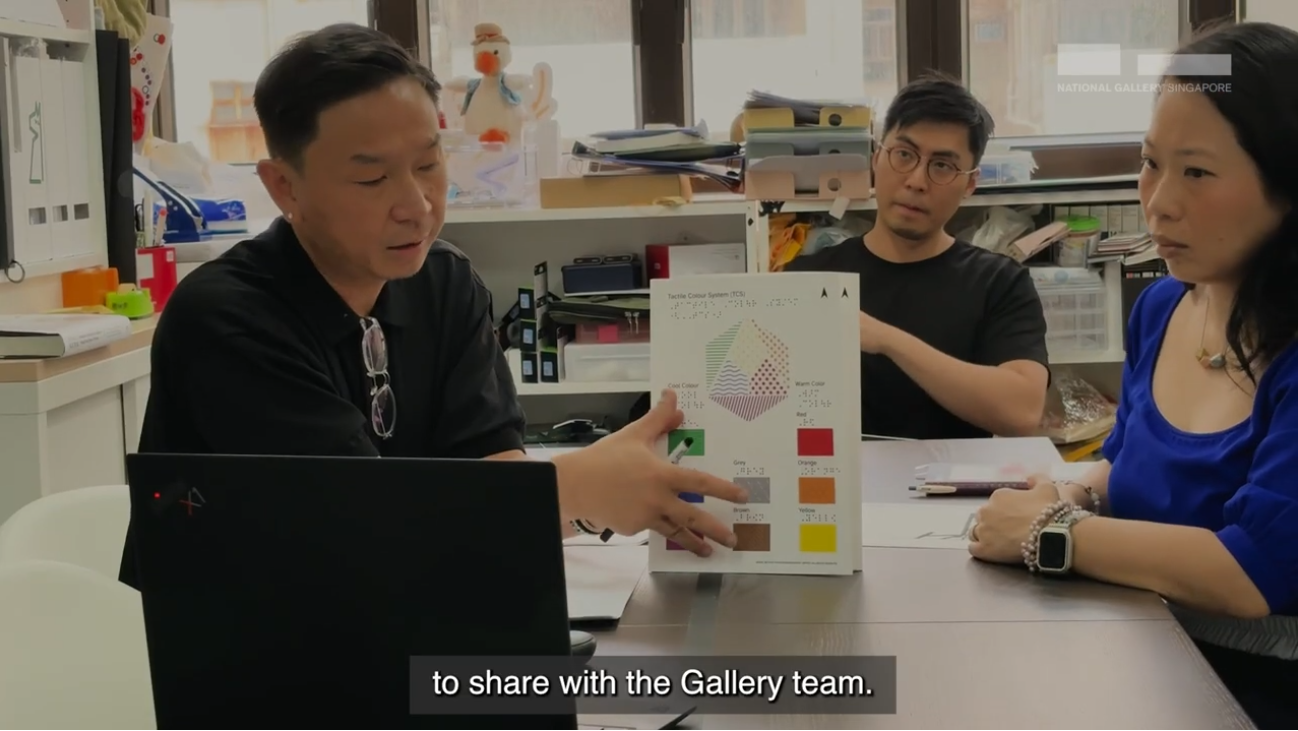
A still from National Gallery Singapore’s (NGS) video on the “HOLD Collection” tactile project, showing the behind-the-scenes of the project. In Beyond Vision International’s (BVI) office with various stationery and documents, Alicia Teng from NGS is seated with two members of the BVI team. They’re all sitting at a table, looking at a laptop placed in the centre of a table, as they have a discussion with other members of the NGS team via Zoom. On the left, Rico Chan from BVI, a middle-aged man with short hair, black t-shirt, and glasses tucked into his collar is talking and showing a page of the Tactile Colour System booklet, which is a guide that shows a list of textures and the colours they correspond to. The page shows an array of colour and texture blocks, accompanied by labels in both written English and Braille. In the centre, a young man with short hair, glasses and black t-shirt is listening intently. On the right, Alicia, who has long hair and a blue blouse, is also listening and paying attention to the laptop screen. Captions at the bottom of the image read: “to share with the Gallery team.”
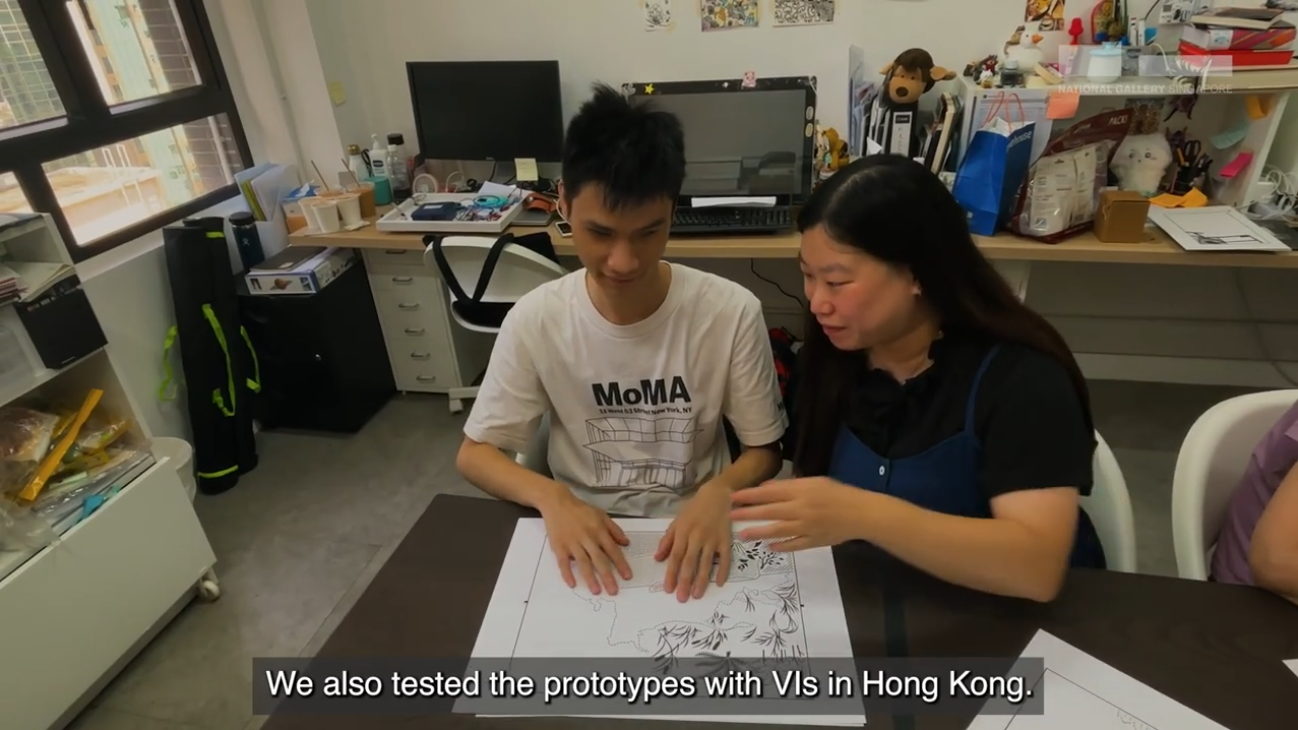
Another behind-the-scenes video still showing Beyond Vision International’s prototype testing session with blind and vision-impaired users in Hong Kong. Two people are sitting at a table in the centre of an office. On the left, a young man wearing a white Museum of Modern Art t-shirt is exploring a Tactile-Audio Interaction System (TAIS) panel for an artwork. The panel shows a black-and white line art rendition of a natural landscape and foliage. He is touching the panel’s textures with both his hands. On the right, a woman with long hair, black shirt, and blue camisole is observing him and gently facilitating the session. Captions at the bottom of the image read: “We also tested the prototypes with VIs in Hong Kong”.
I started out working a lot with the Deaf community focusing a lot on SgSL research. Seeing that there is recognition of sign language as an official language in some of the Southeast Asian countries was really cool—which is a development we’re still lacking here in Singapore. But we are seeing that the community continues to advocate for it.
Pat: I think we’re at a turning point. There’s a growing awareness that accessibility isn’t just a nice-to-have, it’s a right. We’re seeing more conversations happening across sectors, from government to education to arts and tech.
What really motivates me are the grassroots movements. Communities are speaking up, disabled creators are creating their own platforms and reshaping narratives, and cross-border collaborations are centring lived experience. It’s powerful to see how people are no longer waiting for permission to be included as they’re leading the way. It’s encouraging that more organisations are starting to listen, really listen to feedback.
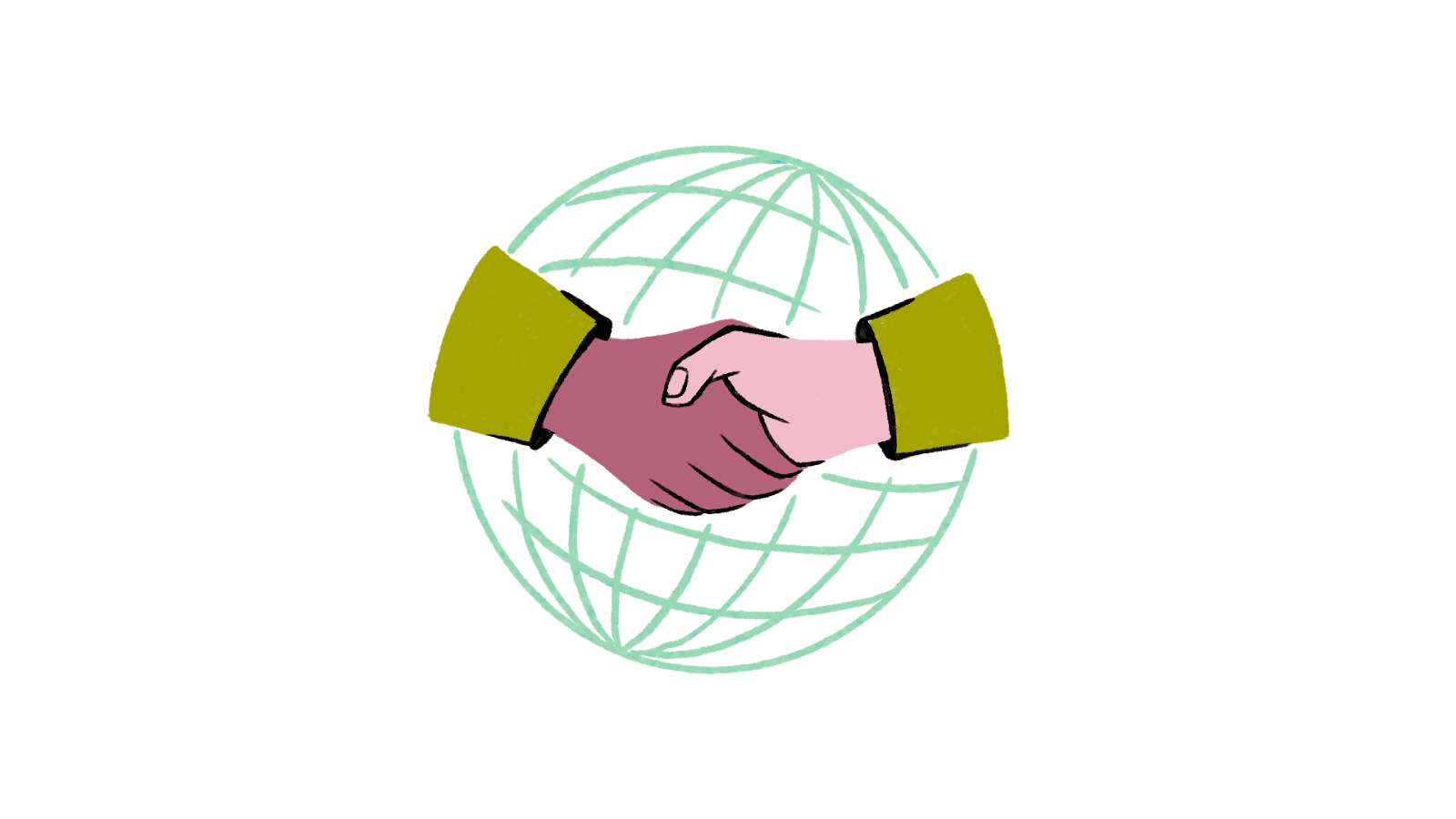
Accessibility should be a right.
Andrew: I grew up in environments where there was practically no access, and this meant “surviving” through writing or gesturing to communicate. When I faced barriers to communication, I felt resigned, and it was something I just got used to. For example when going to doctor appointments, I would gesture “flu” or “cough”, take my prescription and leave. Most doctors generally wouldn't go beyond.
Today, more resources are dedicated to accessibility, which I'm impressed by. Exposing the Deaf community to better accessibility is important, because of that sense of resignation that has become such a norm for them.
Faaiqah: A while back, I went to a workshop in Japan with artists of different disabilities in the room from various countries. There was one Japanese artist who was visually impaired, a wheelchair user, a deaf person, and two interpreters, who were taking turns every 20 minutes. For Singapore we had three deaf people and only one sign language interpreter, so I was a bit jealous. (Laughs)
I was wondering how amazing it must be to have that amount of resources. In 2018 they had already established that kind of resource and practice. Singapore is still so far behind in that sense. It just feels kind of sad.
Accessibility should be a constant work-in-progress.
Have there been specific things in the Singapore context that people within the wider disability space haven't considered yet?
Andrew: Today the number of people who sign—even [amongst] deaf people— are not many. The School of the Deaf has closed down. Most Deaf people are entering mainstream schools and maybe there’s accessibility of some sort in those schools.
I remember back then, Deaf culture and signing was so prevalent. Deaf people have their own culture, just like Chinese, Malay, or any other ethnic group or community. We have our own behaviours, norms, and beliefs, like how to raise a family or what is considered appropriate behaviour. And I hope that it can be seen as equal to other cultures. If Deaf people become the largest group, then maybe it will be easy to learn sign language, no matter where you go.
Faaiqah: In the US they have a disability law. For example, it's compulsory to hire an interpreter when someone requests one, and if not you can take them to court. I hope things like legislation can be applied here in Singapore, because that means you don't have to fight constantly. It's such a tiring and exhausting process.
Minjie: I think this conversation about the law is also very interesting, ‘cause there’s a difference between the US and Singapore. I mean, the law can do great things, but also there are limitations to it.
This is something I learned from a Deaf student I worked with through speech-to-text interpreting, about her exchange experience at a US university. In Singapore, our STTI (Speech-to-Text Interpretation) service typically allows students to make live edits on the document during class—for example, if we misinterpret a technical term, they can correct it immediately, and we adapt in real time.
By contrast, she shared that her remote CART (Communication Access Realtime Translation) experience in the US felt much more rigid. The CART provider struggled with some course-specific terminology, but the student wasn’t able to correct mistakes on the spot because she couldn’t edit the transcript directly.
When I asked why this wasn’t possible, she shared that perhaps it could be related to how in the US context, some access policies were shaped less by what would provide quality access to disabled students, and more by concerns about compliance and defensibility—such as avoiding OCR (Office of Civil Rights) complaints. Hence, some universities are cautious about allowing students to make live edits to the CART transcript. While this may not apply to all institutions, it left me reflecting on how a system that is overly focused on compliance or legal protection can sometimes create new barriers. When processes are driven more by fear than by trust, justice and a liberatory mindset, they can become less responsive to students’ actual needs—even when good intentions are there.
The Future is Disabled.
Minjie: I really love [this book] called “The Future is Disabled” by Leah Lakshmi. It’s about getting people to think about the future being disabled as a joyful future, and not something we should be afraid of. This future is something that is already happening, whether it’s ageing or systemic issues that are disabling whole communities. Disabilities are going to become more common on an individual and societal level.
What would the world be like if disability was at the front and centre of everything—like the way that we relate to each other or form relationships? What would it be like if we have the skillset to talk about our needs and other people’s needs? I think those questions get us to turn to disabled communities who have already been doing that.
Disability is joyful, and there is so much for us to learn from it.
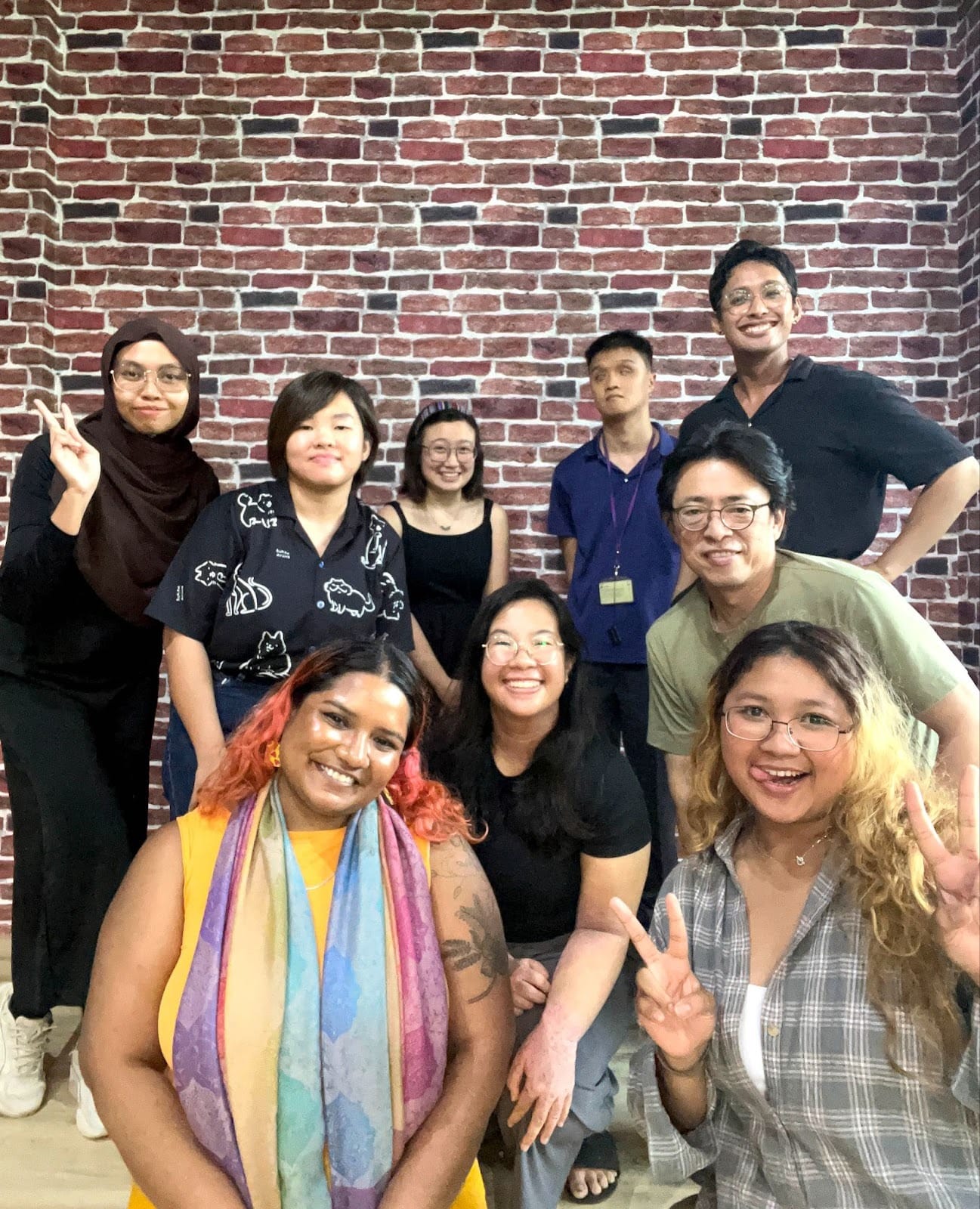
We’d like to thank Equal Dreams for being part of this interview, and for supporting us with valuable insights on how to plan and facilitate an inclusive interview process, ensuring that every member had the opportunity to contribute meaningfully. We’d like to acknowledge the team members who provided sign language interpretation during the session, which enriched the discussion by making space for different modes of communication, and thank them for their care and labour in making the space more accessible and inclusive.
For Part 1 of this interview, please click here.
Equal Dreams was founded in 2020 in the height of COVID, where they started off with providing accessibility services for the deaf and hard-of-hearing as there was a gap in such accessibility services. Currently, Equal Dreams also provides training programmes on disability awareness and accessibility, and consultancy, while also expanding to work with different communities, such as the blind and low vision community, and the neurodivergent community. Interested to learn more about disability accessibility from Equal Dreams? Check out their recently launched Equal Dreams Academy.
More information about the Equal Dreams team:
Clara (she/her) is a Team Lead at Equal Dreams, developing core programmes, providing accessibility services and overseeing content strategy. Her journey into access began with learning Singapore Sign Language in school and later being diagnosed with ADHD.
Hidayat is a Team Lead at Equal Dreams, overseeing programme development and working as an accessibility specialist providing sign language and speech-to-text interpretation. His background in linguistics sparked his interest in Deaf culture, language, and community.
Kah Wee is a Digital Accessibility Specialist at Equal Dreams, providing feedback on websites and digital platforms. Initially a client, he was introduced to accessibility as a profession through the organisation. Being visually impaired, he draws on lived experience to advocate for inclusive digital spaces.
Minjie (she/her) is an Accessibility Specialist and Training Developer providing accessibility services such as Speech-to-Text Interpretation and developing and training core programs. With a background in social justice, she focuses on integrating an intersectional and systemic lens towards disability and accessibility work.
Faaiqah (she/her) is a Singapore Sign Language (SgSL) Instructor, Deaf Interpreter and Social Media Manager. An artist passionate about accessibility, she aims to integrate access into her theatre practice and broaden her work to include diverse disability communities.
Andrew joined Equal Dreams to develop the Singapore Sign Language (SgSL) curriculum, driven by his passion for accessibility and Deaf culture. He aims to create a programme that reflects his vision of effective SgSL education while raising awareness and understanding of the Deaf community.
Patricia is the Digital Accessibility Lead at Equal Dreams driven to create meaningful change rooted in lived experience as a Deaf person. For Patricia, accessibility is personal and empowering; about dignity, independence, and equal opportunity, not just compliance.

